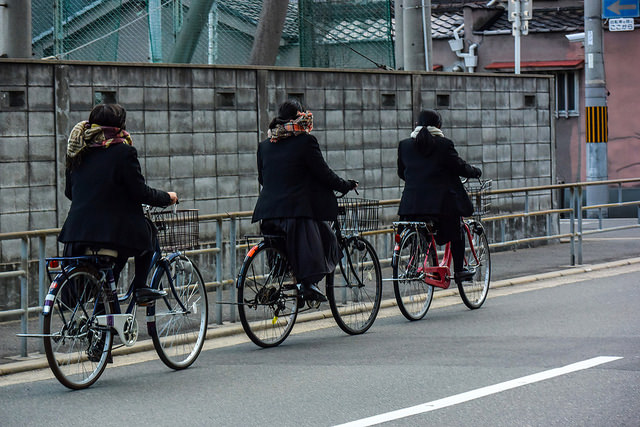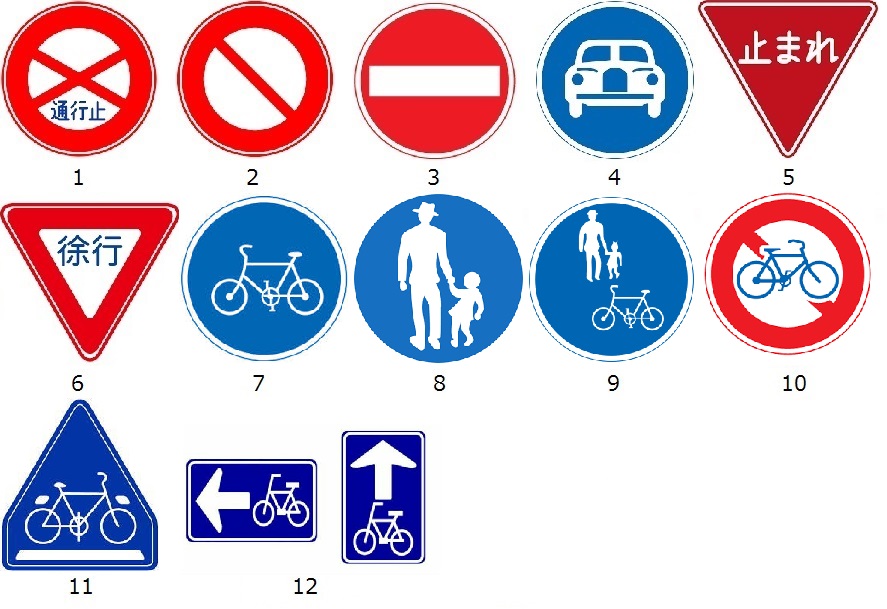
photo by m-louis
While wandering around Japanese city, you may find quite a few people riding bicycles. The number of cyclists typically soars in the morning. Workers and students push pedals like hell to get to the railway station, their companies or schools, and mothers rush on the street with their little children acrobatically loaded on bicycles. As for type of bicycles used in Japan, moderately priced granny’s bikes are more commonly used than road bikes which are standard in many other countries. Rental bike networks that have been developed in recent years in popular tourist destination such as Tokyo, Osaka, Kyoto and Nara also enhance the popularity of cycling in Japan. Before riding a bike in Japan, one thing you should aware of is road rules for cyclist. This column will explain road regulations and cycling manners to safely ride a bicycle in Japan.
RULE 1:Ride on the street in principle
Perhaps you have been confused where on the road to ride a bicycle, on the roadway or the sidewalk? It does look confusing, but a bicycle is recognized as a light vehicle in Japan and cyclist must go on the roadway as a general rule. Cyclists must;
- Ride on the roadway on the street with sidewalks. Riding a bicycle on the sidewalks may be exceptionally permitted.
- Ride on the left side of the road and NOT ride on the right side.
- Use cycle lanes if they are available unless there are unavoidable circumstances.
RULE 2:Riding on the footpath is allowed under some exceptional circumstances
Cyclists must ride on the roadway in principle, however, they are allowed to use sidewalks under the following circumstances.
- Use of sidewalks is instructed by road signs.
- The age of the cyclist is under 14 years old or over 69 years old, or the cyclist is physically disabled.
- There are unavoidable safety risks such as heavy traffic or roadworks on the roadway.
When riding on the sidewalk, cyclists must;
- Ride in the half of the sidewalk closer to the roadway.
- Ride at a low speed.
RULE 3:One person on a bike as a general rule
Bicycles are single use only in principle. Carrying a passenger(s) on a bicycle, for example by using a rear rack, is banned. Also, use of a two-seater bicycle is prohibited on the most of Japanese roads by local governments. Exceptionally, cyclists over 16 years old are permitted to carry a child(ren) under 7 years old on bicycles with a pillion fitted, or on two-infant-passengers bicycles. Use of helmet is highly recommended to protect passenger child(ren)’s safety.
RULE 4:Follow road signs
Same as motorists, cyclists must follow road signs such as a stop sign and slow sign. The following road signs are very important for cyclists while cycling in Japan.

- Closed to vehicles & pedestrians: No vehicles and pedestrians are allowed to enter
- Closed to all vehicles: No vehicles including light vehicles are allowed to enter
- Do not enter: Often placed at one end of a one-way street. No entry allowed from this end
- Motor vehicles only: No pedestrians, light vehicles such as motorbikes under 125cc
- Stop: Vehicles must come to a complete stop
- Slow: Drive at a speed you can immediately stop
- Bicycles only: No pedestrians or vehicle other than bicycles are allowed
- Pedestrians only: No vehicles including light vehicles are allowed
- Pedestrians & bicycles only: Sidewalks or other roads for only pedestrians and bicycles
- Closed to Bicycles: No bicycles are allowed to enter
- Bicycle crossing: A portion of a road where cyclists can cross
- One way (bicycle): Cyclists are allowed to proceed in indicated directions only
RULE 5: Strict penalty for illegal riding
Since the amendment of the Road Traffic Act on 1st June 2015, traffic rules and regulations for cyclists have been strengthened. A large number of serious traffic accidents caused by cyclists, often involved heavily injured or even deceased, are in the background of this amendment. The new Road Traffic Act appoints 14 cycling offences and offenders are to be penalized according to the law. It is important for foreign nationals to follow traffic rules as they are subject to the regulations too.
- Ignoring a traffic light
- Riding in prohibited areas
- Ignoring road signs such as a slow sign
- Riding in the incorrect lane
- Obstructing pedestrians on side of road
- Invading in a railroad crossing when a gate is closed
- Obstructing the flow of priority vehicles at intersections
- Obstructing right turning traffic at intersections
- Unsafe riding art roundabouts
- Ignoring stop sign
- Obstructing pedestrians on sidewalks
- Faulty maintenance of brake
- Riding under the influence
- Other unsafe ridings
※Examples of ” Other unsafe ridings” include holding an umbrella, using a cell phone or using earphones while cycling.
All cyclists aged 14 years or older are subject to the regulations. In case of road accidents caused by underage cyclists, their parents or guardians must bear responsibility for any damages or detriments occurred in the accidents. Penalties for cycling offences range from “Fines up to 20000yen“ to “Imprisonment up to 5 years or fines up to 1million yen”. Serious offences carry tough penalties. In addition, repeat offenders who are arrested for unsafe cycling twice or more within the past three years will be ordered to attend safe cyclist courses by the prefectural public safety commission. Disobeying the order will be strictly penalized by fines up to 50000yen.
I want to ride my bicycle, I want to ride it where I like
Cycling has been loved by the Japanese as affordable means to travel for a long time, though, road regulations for unsafe cycling haven’t been developed until recent times. It was 2015 that stringent standards for cycling came into effect as a result of the increasing number of serious road accidents involving cyclists. Also, many more foreign cyclists have ended up in road accidents in Japan due to little understanding of cycling rules. It is important to review the road regulations before cycling in Japan.
